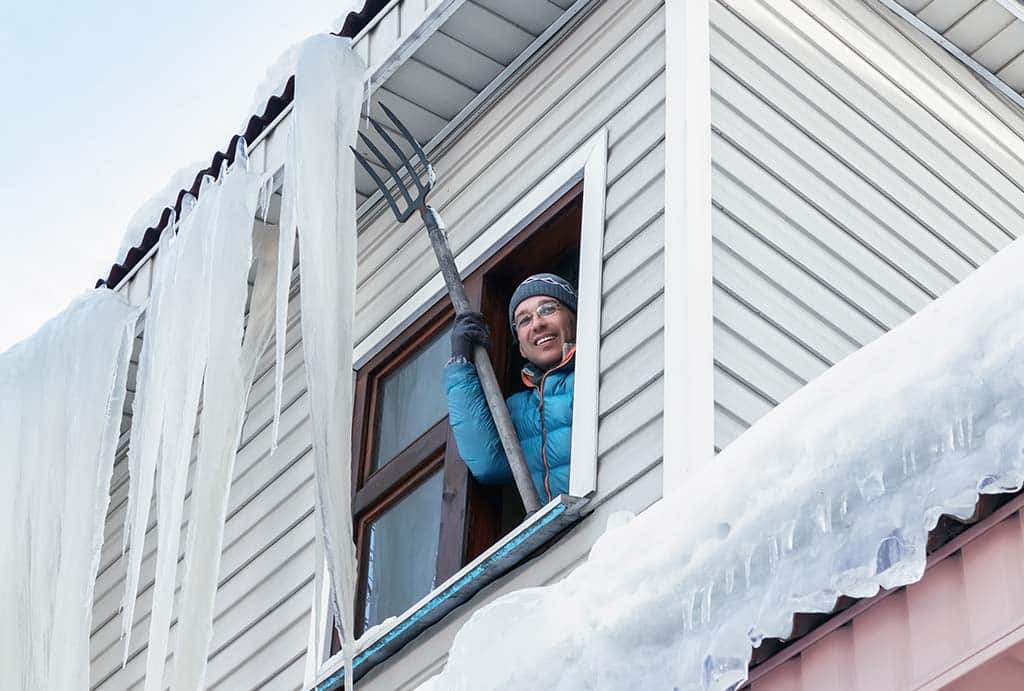Sub-freezing temperatures and warmer sunny periods during the day can create one of the many breath-taking sights of a winter wonderland-icicles. While these icy creations are pretty in scenic pictures and are considered a part of the winter season, they do have a darker and even dangerous side. Icicles can actually pose a real danger to people, pets, and property, especially if they are not removed the correct way. That is why we here at Stay Dry Roofing wanted to take some time to address the importance of dealing with icicles on the roof in a safe and effective manner.

Dangers icicles pose
Clogged gutters and downspouts are among of the biggest contributors to icicle formation. When the gutters cannot drain properly the water backs up and freeze into sheets and rivers of ice. Icicles on the roof will begin to form and grow. To prevent icicles from forming, keep your gutters clear of leaves, needles, and other debris. Clogged gutters will quickly accumulate ice and snow which can drastically increase the weight the gutters and eaves of our home are having to support. It is common for gutters to tear off the roof under the sheer weight of ice and snow. This can damage the roof and property around the home and can seriously injure anyone in the vicinity. When gutters are clogged you can also get ice dam formations along with icicles on the roof. “The three things necessary to form icicles — snow, heat to melt the snow and cold weather — are also needed to form ice dams… Ice dams form when warm air from inside your home melts snow on the roof. When the meltwater reaches the colder eaves (the part of the roof that extends beyond the walls), the water refreezes and creates a buildup of ice along the edge of your roofline, states the Insurance Institute for Business and Home Safety” (IBHS). So, icicles hanging from a roof could indicate a serious ice dam problem but it is important to remember that ice dams can form with no icicles on the roof and icicles can form even when there is no ice dam present at all.
Protecting people, property, and pets
When too much ice builds up, the sheets of ice can break off, icicles can snap and fall and heavy snow drifts can fall, causing damage to people and property below. Trying to chip the ice from the gutters and trying to knock off the icicles on the roof while balancing on a ladder are both extremely dangerous and can cause even more damage and greater injury. When you have a problem with ice and snow accumulation and have icicles you need to safely remove, it’s best to enlist the support of a roofing professional. Melting snow and ice can cause water damage to your roof and attack and dripping icicles can cause water damage to your eaves and the foundation of your home. The best way to protect your home from water damage and damage caused by heavy ice and snow and the best way to protect your family and pets from the dangers of falling icicles and snow packs is to call in professional roofing help.
Thousands injured from falls off ladders
Before you clean your gutters, however, make sure you review your ladder safety notes and follow proper ladder safety measures. In the United States, falls from ladders is a leading cause of home-based injuries. “Ladder-related injuries per 100,000 people rose almost 27 percent during the 16-year study period — 97.3 percent occurred in non-occupational settings, such as homes and farms. More than 2.1 million people needed to be hospitalized, about twice the overall admission rate for consumer-product related injuries” (ISHN). If it is not worth the risk of a fall to try and get your roof and gutters cleared off. Always know your limits and if you do not feel you can do it safely and properly then wait till you are able to call in expert help to deal with ice, snow, and icicles on the roof!
Ladder Safety 101
If you do decide to get on a ladder to deal with snow and icicles on the roof then follow these basic ladder safety tips each and every time!
- The ladder should extend at least 3 feet over the roofline to ensure you are not reaching too far back behind the center of gravity.
- Always use a ladder on flat ground and make sure you are using leg levelers to balance the ladder when using one on soft or uneven ground.
- Check the ladder’s maximum load rating and make sure your weight combined with any supplies you are carrying does not exceed the weight limits.
- Straight and adjustable ladders should not be used unless they have slip-resistant feet and are in good working order.
- Do not use a metal ladder if your roof has power lines running to it and do not use near power lines or electrical equipment; a wood or fiberglass ladders is safer.
- Make sure to inspect the ladder before using it and make sure all rungs, locks, and spreader braces are in good order and properly engaged before getting on the ladder.
- If possible, have someone with you who can hold the ladder and act as a spotter for you while you are on the ladder and on the roof as well.
Hire a contractor
Getting on your roof yourself is not recommended if you’re not used to regularly climbing ladders at those heights. If you do not use ladders on a regular basis as part of your job and are not rained in proper ladder safety measures it is best to call in the experts rather than risking it on your own. When looking for a roofing contractor, make sure you check to ensure you are working with a professional company and area avoiding scams and fakes. Ask to see their business license, proof of insurance, certifications, permanent business address, and Better Business Bureau rating. Here at Stay Dry Roofing, we have decades of experience and years of hands-on training and our team of roofing experts are ready to go to work for you. Call us today to schedule a free consultation appointment and let us show you what we can do for you and how we can help you deal with icicles on the roof safely!
